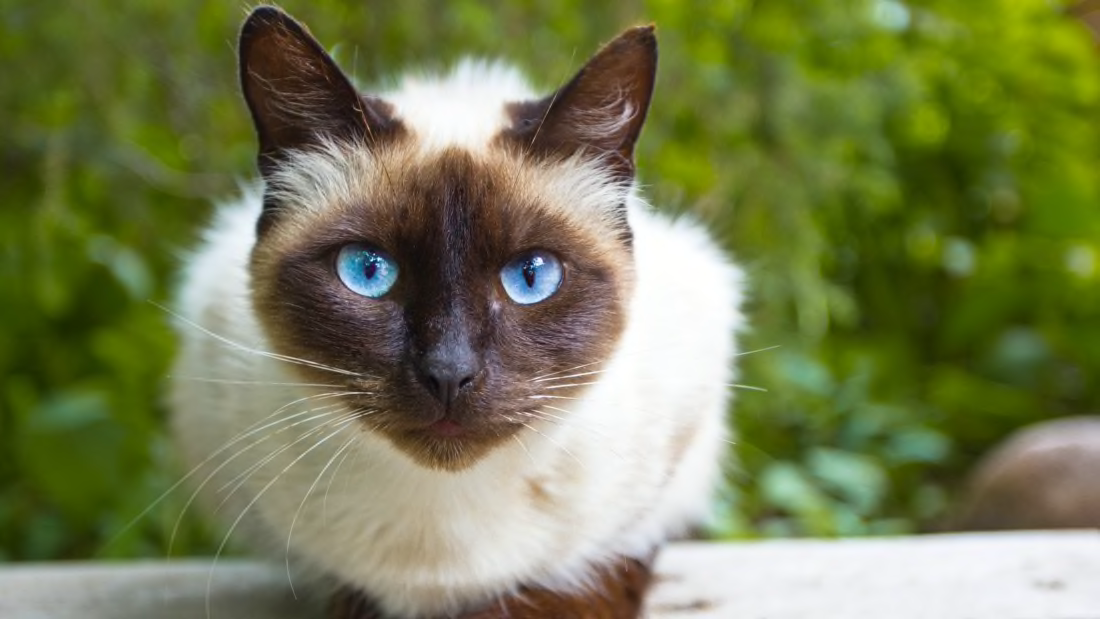As their name suggests, Siamese cats are descended from felines born in Siam, or modern-day Thailand. No one quite knows how the sleek feline made its way to American shores during the late 19th century. However, thanks to its sociable nature, lithe body, and dark-tipped creamy coat, the Siamese became one of the country’s most beloved cat breeds.
Currently, it is the 12th most popular kitty in the U.S., according to registration statistics compiled by the Cat Fanciers’ Association (CFA). Curious to learn more? Impress ailurophiles with these 13 bits of trivia about the blue-eyed beauties.
1. THE SIAMESE IS AN OLD BREED.
Like most cat breeds, the Siamese’s true origins are cloaked in mystery. Some people say the cats were the pets of royalty, while others believe they were raised by Buddhist monks. However, a Thai manuscript called the Tamra Maew, or ‘The Cat Book Poems,’ provides an early depiction of the country’s dark-pointed cats. The work was produced sometime between the 14th and 18th centuries. This suggests that the Siamese is a very old breed—even if we don’t quite know where it came from.
2. A U.S. PRESIDENT OWNED A SIAMESE CAT.
Cat lovers brought the Siamese to America in the late 19th century, but there are mixed reports about when—and how—it traveled across the pond. Some say the Siamese first appeared in the U.S. courtesy of an American naval officer, who picked up two cats while on a tour of duty in Southeast Asia. Others claim an American friend of the King of Siam was given Siamese cats as a gift, or that renowned opera singer Blanche Arral brought them back to America after touring Siam. And from 1889-1890, a Chicago cat club lists several registered Siamese cats, one of which was “imported from Siam” by its founder.
But what really put Siamese cats on the map was when U.S. Consul David Stickles, a diplomat at the consulate in Bangkok, gave President Rutherford B. Hayes’s wife Lucy a Siamese cat named Siam in the late 1870s. “I have taken the liberty of forwarding you one of the finest specimens of Siamese cats that I have been able to procure in this country,” he wrote to the First Lady. “I am informed that it is the first attempt ever made to send a Siamese cat to America.”
Sadly, Siam fell ill and died after less than a year in the White House. According to legend, the president’s steward requested that the cat’s body be preserved. However, no stuffed kitties were ever discovered, suggesting that the tale might be more fanciful than fact-based.
3. SIAMESE CATS SUPPOSEDLY MADE AN APPEARANCE AT THE WORLD’S FIRST MAJOR CAT SHOW.
According to some sources, Siamese cats were showcased at the world’s first major cat show, a national competition at London’s Crystal Palace in July 1871. The occasion reportedly marked the first time anyone in England had ever seen a Siamese cat. Harper’s Weekly described the exotic animals as “… soft, fawn-colored creatures, with jet-black legs—an unnatural, nightmare kind of cat, singular and elegant in their smooth skins, and ears tipped with black, and blue eyes with red pupils.”
However, other historians argue that the dark-tipped cats described by onlookers weren’t true Siamese cats, and that the breed didn’t make an appearance in England until much later. All parties, however, agree that British Consul-General Owen Gould brought two Siamese cats, Pho and Mia, from Thailand to London in 1894. The pair gave birth to kittens, and the cat family was displayed at the Crystal Palace cat show of 1895.
4. SIAMESE CATS ONCE HAD CROSSED EYES AND CROOKED TAILS.
Many Siamese cats once had kinked tails and crossed eyes. Cat fanciers viewed these traits as undesirable, and gradually eliminated them via selective breeding. However, these physical quirks were once the stuff of myth. According to legend, a Siamese cat was tasked with guarding a golden goblet for the king. Ever the loyal subject, the feline clutched the cup so hard with her tail that it bent, and stared at it for so long that her pupils lost focus.
Today, you’ll occasionally still come across a cross-eyed Siamese, or one with a crooked tail. If you do, make sure to salute it for its honorable service.
5. THEY ALSO HAD STOCKIER BODIES AND ROUNDER FACES.
The Siamese originally had a heavier body, and a face that was more round than triangular. However, mid-20th century cat fanciers favored an exaggerated silhouette, and gradually bred the Siamese into the lean, fine-boned feline it is today. You’ll only see this new variety in cat shows, but some breeders continue to produce Siamese kittens with a more “traditional” look. The International Cat Association also accepts a new breed called the Thai, which looks like an old-school Siamese with its soft cheekbones and stocky frame.
6. THEIR TIPS ARE “TEMPERATURE-CONTROLLED.”
Ever wondered why a Siamese cat has a white coat and dark-tipped paws, ears, and facial features? It stems from a temperature-sensitive enzyme, which causes the cat to develop the color on the cooler parts of its body and stay pale on its warmer torso. Siamese kittens are born with all-white fur, and develop their points when they’re several weeks old.
7. THEIR TIPS ALSO VARY IN COLOR.
Originally, cat fanciers’ organizations only recognized Siamese cats with dark brown points, called Seal Points. Today, they accept a range of color points, include blue, chocolate, and lilac.
8. A SIAMESE WAS ONCE THE WORLD’S “FATTEST CAT.”
The Guinness World Records doesn’t keep tabs on the world’s fattest living animals, since officials don’t want to encourage people to overfeed their pets. But a Siamese cat namedKaty could have easily claimed the title in 2003. The five-year-old kitty hailed from Asbest, a Russian city in the Ural mountains. She was given hormones to stop her mating, which caused her to develop a voracious appetite. Katy ended up ballooning to 50 pounds, making her weigh a tad more than a six-year-old human. (The average male Siamese typically weighs between 11 and 15 pounds, and females between 8 and 12 pounds.)
It’s unclear whether Katy is still alive today, but one thing’s for sure: She tipped the scales way more than Elvis, a 7-year-old male cat from Germany that social media labeled “the world’s fattest cat” in 2015.
9. SIAMESE CATS HAVE SHINED ON THE SILVER SCREEN.
The 1965 film That Darn Cat! features Hayley Mills as a suburban teen named Patricia “Patti” Randall, but the movie’s real star is Darn Cat, or “DC,” a Siamese tomcat that helps Patti foil two robbers’ kidnapping plot.
DC was played by a Seal Point Siamese named Syn. He was left at an animal shelter at the age of two because he was “standoffish,” and an animal trainer adopted him for $5. The orphaned Syn became the first catto win a PATSY Award, an honor granted to animal performers by the Hollywood office of the American Humane Association. (Due to a lack of funding, the PATSY Awards were discontinued in 1986.)
Siamese cats have also graced the silver screen in The Incredible Journey(1963) and Bell, Book and Candle (1958), and have appeared in animated form in Lady and the Tramp (1955).
10. SIAMESE CATS FOILED AN ESPIONAGE PLOT.
In the 1960s, two Siamese cats at the Dutch Embassy in Moscow, Russia, knew that something wasn’t quite right. The pet kitties were asleep in then-ambassador Henri Helb’s study when they suddenly woke up and began arching their backs and clawing at a wall. Helb suspected that the agitated felines heard a noise that didn’t register with the human ear. He was correct: An investigation revealed 30 tiny microphones hidden behind the wall.
Instead of protesting the Russian government’s espionage, Helb and his staff decided to use it to their advantage. They lingered in front of the microphones and strategically complained about delays in embassy repairs, or packages stuck in customs. Within 24 hours, these problems were “mysteriously” resolved.
~Faith Middemiss



